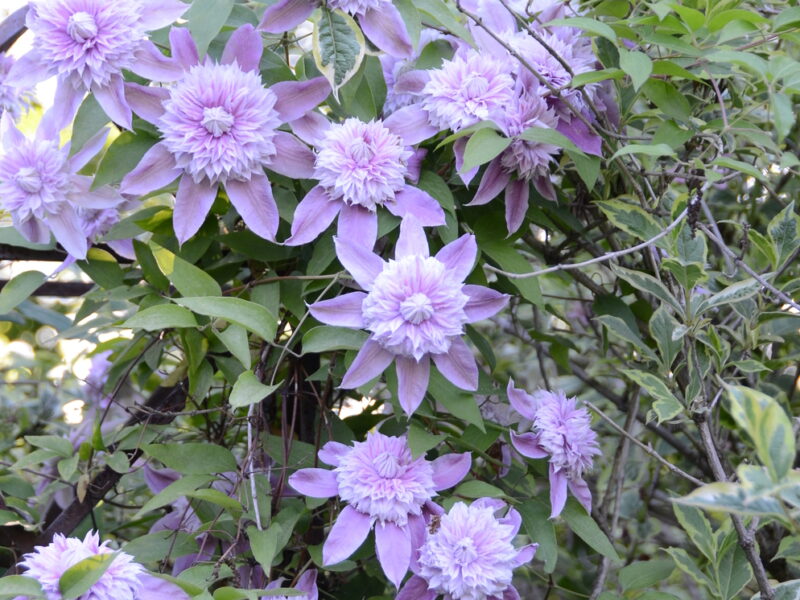

This week a continued look at the Queen of Vines, the Clematis.
Hopefully, after reading last week’s column you developed an interest or rekindled your interest in Clematis. Some varieties, once established, need only minor pruning and care. Others may require more attention. I also mentioned that the tendrils on the vines that provide a means of attachment to stakes and cages twine counterclockwise. Try as you will, this can’t be changed.
Another consideration when growing clematis is weed trimmers. If you use a weed whacker or string trimmer, keep them far from your clematis plantings, and if you’ve got someone else who does your mowing and trimming caution them as well. Just the slightest slip or misjudgment around the stems of clematis can sever the stem from the crown near the ground. In most cases, especially when the vines are fully extended in the summer, cutting a vine will result in the death of the vine if not the entire plant. Been there, done that. Maybe have a chat with your landscaper or gardener so they know where these vines are?
When tying the vines you need to be very careful. I always use natural twine and do any tying using a figure 8 tie to ensure that the vine has room to move. When tied too tight or tied directly to a stake, a vine can easily snap in a gust of wind. Taming the vines must start from the day you plant them, if not sooner, as in the nursery and garden center. If you’ve bought prepackaged or bare-root plants, once they are in the ground you need to provide a stake for climbing immediately. If your initial stem breaks, that’s it, end of story.
When you need to make attachments to a stone wall or another object, you can find tabs with adhesive backing and a wire attached just for this purpose. There are also lead and metal spikes that can be hammered into walls and cement that have short metal tabs that can be wrapped around the vine for support. You won’t find these in most garden centers, but try the best, and if not there, look online. “Soft Twist” ties can also be used. This is foam-covered wire that can be purchased at garden centers and online.
While there are about 20 or so varieties of Clematis that you can find at local garden centers, there are upward of 200 clematis vines that you can buy from specialty growers such as donahuesclematis.com where you’ll find nearly 50 varieties.
About a decade ago I had a very interesting Clematis experience when I was sent a vine to trial from a well-known marketer. I planted the specimen in my trial garden and began to keep notes on it for a few years only to receive a note that the plant sent may be infringing on a patent. I was ordered or asked to destroy the plant. I didn’t.
That plant, Clematis “Huvi,” is now not only trademarked but it is covered by U.S. plant patent 22901. It still grows in my garden on vines about 4 to 6 feet tall with a flower color that I’d call blood or oxblood red. It begins flowering in June and continues well into the summer, and after a decade it remains one of my favorite varieties. Many more Clematis have been “invented” or hybridized right here in the United States, and a few have snuck in from Eastern Europe (like Huvi, which came from Estonia) but the vast majority of the recent introductions have come from the British grower and hybridizer Raymond Evison.
Evison has debuted a host of his new introductions, some of which were developed in conjunction with Danish nurseryman Poulsen Roser. At the Chelsea Flower Show in 2010 he showed an astounding 2,000 plants that spanned his more than 30 years of work. In 2011 he presented at least 10 new varieties but what’s really exciting is that he’s now got a stable of Clematis that are perfect for those of us who may be intimidated by 15-to-20-foot vines that can get destroyed by our oft-manic winds.
Evison’s new short and compact vines are perfect for patios, planters, deep window boxes and balconies as well as in the garden. Many of his introductions are only available from specialty growers, but I was in a Southampton garden center a few years later and the manager said, “Hey, we got these Clematis and they’re new …” and sure enough they had the Evison name on the tag.
Many more introductions have shown up on this side of the puddle, but keep your eyes peeled for Ooh La La, Cezanne, Parisienne, Picardy, Chantilly, Angelique and Fleuri, which all grow to a very manageable 4 feet. In the 6-to-8-foot category, look for Josephine, Bourbon, Shimmer and Rebecca. There are also many new doubles and, in this group, watch for Arctic Queen and Diamantina. Evison also has a number of books on the subject so if you’re looking for a reference check out his titles. There are also some very interesting bi-colored varieties.
Grown in tubs and planters, many of these plants make excellent terrace or patio plants. Tubs should be at least 12 inches in diameter and 12 to 18 inches deep. Remember that these plants need good drainage so make sure that there are adequate holes in the bottom. If possible the tubs should be shaded to keep the root cool while the vine itself grows in full to partial sun. Soil mixes should consist of 50 percent soil (topsoil out of a bag is best) mixed with 50 percent peat-lite mix such as Pro-Mix. Add a time-release fertilizer to the mix such as Osmocote and try to use 2-to-3-year-old plants. Remember that these are vines and know the habit of the variety that you’re growing so you can provide it with the proper support or trellis.
For outdoor planting, dig a hole 2 feet deep and 12 inches wide. The hole should be filled with a mixture of good loam mixed with peat moss, and be very careful not to twist or break the stem base where the roots are attached. Most important is to protect this area from direct sun — that is, the bottom three inches of the stem after it is planted. A mulch of salt hay or pine needles will do, but it’s this step that is usually ignored and results in failure.
Remember to give the plants something to climb on. Give them something to attach themselves to or they will languish. They do not really twine but climb by attaching their leaf petioles around some means of support like thin trellis, bamboo stakes or even wire or string. In our greenhouse we had a C. florida that attached itself to the bench supports and in the garden one plant grew up and through a magnolia, another high into a hemlock hedge and a third up and along a yew hedge. Another forms an umbrella-like spray up and through a wrought iron dome.
There is also a native clematis (well, native to Pennsylvania) that may appeal to many gardeners, including those who like to go on the wild side. It’s called Clematis viorna, or leatherflower. It grows to 12 feet in length and has somewhat dainty but interesting flowers in shades of purple. It should be pruned to the ground once it’s completely dormant.
Clematis are heavy feeders just like tomatoes. They should get their first application when you see buds forming, then every four to six weeks while buds are developing. The best method is a granular organic fertilizer high in phosphorus and potassium but lower in nitrogen so look for a ratio similar to 1-2-2. When in doubt or if you don’t have the right fertilizer, you can always use an organic tomato fertilizer.
And speaking of pruning, this is where most gardeners go very wrong with Clematis. The plants are grouped into three pruning classes. Pruning yours wrong can kill it or keep it from flowering. This is why it’s so important to label these plants with their name and their pruning group number. Keep growing.
 More Posts from Andrew Messinger
More Posts from Andrew Messinger